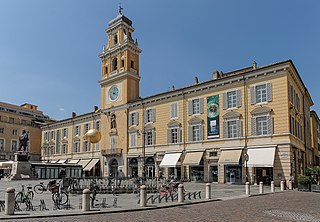
Parma is a city in the northern Italian region of Emilia-Romagna known for its architecture, music, art, prosciutto (ham), cheese and surrounding countryside. With a population of 198,292 inhabitants, Parma is the second most populous city in Emilia-Romagna after Bologna, the region's capital. The city is home to the University of Parma, one of the oldest universities in the world. Parma is divided into two parts by the stream of the same name. The district on the west side of the river is Oltretorrente. Parma's Etruscan name was adapted by Romans to describe the round shield called Parma.

Grosseto is a comune in the central Italian region of Tuscany, the capital of the province of Grosseto. The city lies 14 kilometres from the Tyrrhenian Sea, in the Maremma, at the centre of an alluvial plain on the Ombrone river.
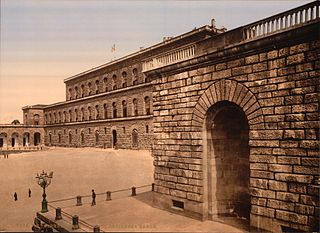
The Palazzo Pitti, in English sometimes called the Pitti Palace, is a vast, mainly Renaissance, palace in Florence, Italy. It is situated on the south side of the River Arno, a short distance from the Ponte Vecchio. The core of the present palazzo dates from 1458 and was originally the town residence of Luca Pitti, an ambitious Florentine banker.

Palazzo Schifanoia is a Renaissance palace in Ferrara, Emilia-Romagna (Italy) built for the Este family. The name "Schifanoia" is thought to originate from "schifare la noia" meaning literally to "escape from boredom" which describes accurately the original intention of the palazzo and the other villas in close proximity where the Este court relaxed. The highlights of its decorations are the allegorical frescoes with details in tempera by or after Francesco del Cossa and Cosmè Tura, executed ca 1469–70, a unique survival of their time.

The Museo Lombardi is a museum displaying an eclectic collection of 19th-century art and cultural works from Parma. It is located in the Palazzo di Riserva on Strada Garibaldi #5 in central Parma, Emilia-Romagna, Italy.

Palazzo Farnese is a palace in Piacenza, northern Italy.

The Ducal Palace, also known as Reggia di Colorno, is an edifice in the territory of Colorno, Emilia Romagna, Italy. The palace we see today was refurbished by Francesco Farnese, Duke of Parma in the early 18th century on the remains of a former castle.

The Palazzo Colonna is a palace in central Rome, Italy, at the base of the Quirinal Hill, and adjacent to the church of Santi Apostoli. It is built in part over the ruins of an old Roman serapeum, and it has belonged to the prominent Colonna family for over twenty generations.
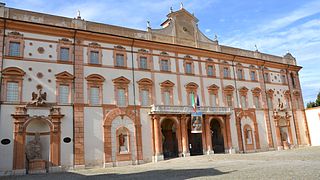
The Ducal Palace in Sassuolo is a Baroque villa located in the town of Sassuolo, thirty minutes outside Modena, northern Italy.

The Palazzo della Pilotta is a complex of edifices located between Piazzale della Pace and the Lungoparma in the historical centre of Parma, region of Emilia Romagna, Italy. Its name derives from the game of pelota played at one time by Spanish soldiers stationed in Parma.
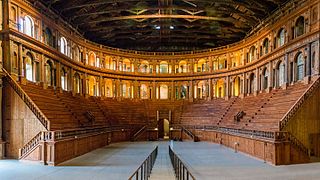
Teatro Farnese is a Renaissance theatre in the Palazzo della Pilotta, Parma, Italy. It was built in 1618 by Giovanni Battista Aleotti. The idea of creating this grand theater came from the Duke of Parma and Piacenza Ranuccio I Farnese. It was part of the complex of the Ducal Palace of Parma. The theatre was almost destroyed by an Allied air raid during World War II (1944). It was rebuilt and reopened in 1962.

The Biblioteca Palatina or Palatina Library was established in 1761 in the city of Parma by Philip Bourbon, Duke of Parma. It is one of the cultural institutions located in the Palazzo della Pilotta complex in the center of Parma. The Palatina Library was named after Apollus Palatinus.
Giovanni Battista Magnani was an Italian architect working entirely in Parma in the first half of the 17th century. He was the most successful of a family of masons and architects that included his father Nicostrato and his son Carlo.

The Royal Palace of Milan was the seat of government in the Italian city of Milan for many centuries. Today, it serves as a cultural centre and it is home to international art exhibitions. It spans through an area of 7,000 square meters and it regularly hosts modern and contemporary art works and famous collections in cooperation with notable museums and cultural institutions from across the world. More than 1,500 masterpieces are on display annually.

Giuseppe Alinovi was an Italian painter, mainly painting vedute in a Neoclassical style, often in light watercolors. The Italian composer and court organist Giuseppe Alinovi was his father.
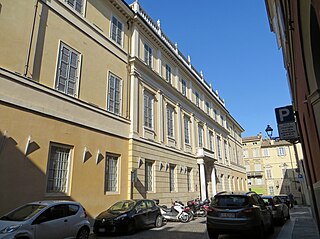
The Palazzo Sanvitale is a palace located on Piazzale Sanvitale #1 in central Parma, region of Emilia-Romagna, Italy. The palace now houses a museum.

Giuseppe Drugman was an Italian landscape and cityscape painter.

The Bodoni Museum of Parma is a museum dedicated to Giambattista Bodoni (1740–1813), situated in the Palazzo della Pilotta building on the premises of the Palatina Library.

The Palazzo del Giardino or Palazzo Ducale del Giardino is a historic palace in the Parco Ducale in Parma. It is not to be confused with the official Parma residence of Marie Louise, Duchess of Parma between Palazzo della Pilotta and Palazzo della Provincia in what is now known as piazzale della Pace - she also lived at the Ducal Palace of Colorno and in the Casino dei Boschi in Sala Baganza. The main Ducal Palace in Parma, the Palazzo della Pilotta and the Reinach Theater were all destroyed in an early morning air raid on 13 May 1944, carried out by the 465th Heavy Bombardment Group of the US Airforce, 781st Squadron, which dropped 9 GP bombs on the city centre.

The Ducal Palace of Parma was a neoclassical palace in Parma, Italy. It was located on the west side of the Piazzale della Pace. Between its construction and 1859, it was the residence of the Dukes of Parma. After 1859, it became the prefecture.


















